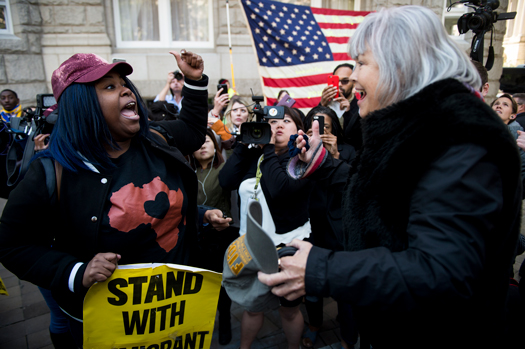By Final Call News

When writer Andrew Hacker looked at race and reality in America, he reached a telling and almost prophetic conclusion. Inside the United States, he wrote, there were “Two Nations: Black and White, Separate, Hostile, Unequal.”
Race, the ugly bedrock of American history, had shaped and would continue to shape life and perceptions of life in this country, his book essentially concluded.
His observations and research, first published in 1992, laid out what we know about the truth of race and existence in America. They also highlight the first-class failure of the world’s greatest democracy to grant a full and complete freedom to its so-called Black citizens.
America’s problem remains in the 21st century, as Black intellectual W.E.B. DuBois noted in 1903, the problem of the color line. Dr. DuBois left America, spending his later years working and then dying in Ghana. He apparently no longer dreamed of an integrated American utopia after a lifetime of work and sacrifice to make America better.
Two Nations: Black and White, Separate, Hostile, Unequal.
Blacks are deprived, denied and discounted in almost every area of life in the United States: Blacks and Whites don’t live together. Statistics from the Census Bureau’s 2010-2014 American Community Survey allow calculation of neighborhood racial attributes and segregation measures. Looking at 52 of the country’s largest metropolitan areas, with at least 20,000 Black residents, more than half of Blacks would need to move to achieve complete integration.
Housing segregation becomes a harbinger for failure as Black areas are deprived of services, jobs, opportunity, healthy food and even places to exercise. In education, some “2 million black students attend schools where 90 percent of the student body is made up of minority students. … Minority students represent 57 percent of the population in ‘dropout factories’–schools where the senior class has 60 percent or fewer students who entered as freshmen,” reported U.S. News & World Report in “U.S. Education: Still Separate and Unequal,” published in 2015.
A Pew Research Center analysis found in “2016, the median wealth of white households was $171,000. That’s 10 times the wealth of black households ($17,100)–a larger gap than in 2007.”
Wealth is lacking, how about health? “Blacks have a higher mortality rate than any other racial or ethnic group for eight of the top 10 causes of death. Cancer rates among Blacks are 10 percent higher than those for White Americans. Blacks are almost twice as likely to have diabetes as non-Hispanic Whites. Blacks are six times more likely than Whites to be homicide victims,” The Atlantic magazine said in 2015. “Blacks account for nearly half of new HIV infections but less than a quarter of the total population. Blacks make up a third of patients receiving kidney dialysis.”
The International Journal of Health Services observed, “youthful transgressions that might result in referral for treatment among non-minority children more often incur criminal sanctions for minorities. Overall, blacks and Hispanics account for 63 percent of the children detained in juvenile facilities.”
The American Civil Liberties Union reported, “The War on Drugs has been a war on communities of color. The racial disparities are staggering: Despite the fact that white and black people use drugs at similar rates, black people are jailed on drug charges 10 times more often than white people are. Black people are also three times more likely to be arrested for marijuana than white people are.”
“One in three black men can expect to be incarcerated in his lifetime. … At no other point in U.S. history have so many people–disproportionately people of color–been deprived of their liberty,” the ACLU noted.
According to the Sentencing Project, “Today, people of color make up 37 percent of the U.S. population but 67 percent of the prison population. Overall, African Americans are more likely than white Americans to be arrested; once arrested, they are more likely to be convicted; and once convicted, they are more likely to face stiff sentences. Black men are six times as likely to be incarcerated as white men and Hispanic men are more than twice as likely to be incarcerated as non-Hispanic white men.”
Blacks obviously fare no better in policing with one Pew survey reporting “that 76 percent of blacks, compared with 33 percent of whites, believed there was a problem with the justice system when it comes to law enforcement and race.”
Pew surveys have consistently found race gaps when it comes to beliefs about policing and fairness. A 2014 survey with USA Today found “70 percent of blacks say police departments around the country do a poor job in holding officers accountable for misconduct; an identical percentage says they do a poor job of treating racial and ethnic groups equally. And 57 percent of African Americans think police departments do a poor job of using the right amount of force.”
“An overwhelming majority of blacks (88 percent) say the country needs to continue making changes for blacks to have equal rights with whites, but 43 percent are skeptical that such changes will ever occur,” according to Pew Research Center Social & Demographic Trends “On Views of Race and Inequality, Blacks and Whites Are Worlds Apart 2016.”
So the question is not whether Black people can make it in a separate state or territory, as called for by the Most Honorable Elijah Muhammad and his servant, Min. Louis Farrakhan. The question is can Blacks afford to continue to suffer and die under the tyranny and oppression of America’s political reality?












